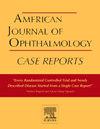Late onset bilateral annular subepithelial corneal haze after LASIK
Q3 Medicine
引用次数: 0
Abstract
Purpose
Corneal haze is uncommon after laser assisted in situ keratomileusis (LASIK). Post-LASIK haze and scarring can develop due to different conditions such as infectious keratitis, LASIK flap complications, diffuse lamellar keratitis (DLK), corneal photo disruption and damage to the basement membrane due to effects of femtosecond laser, or unknown causes such as in central toxic keratopathy (CTK). In this report, we describe a patient with bilateral late onset annular subepithelial corneal haze which presented more than 20 years after LASIK.
Observations
A 65-year-old woman who presented with decreased vision in both eyes (Best corrected visual acuity [BCVA] 20/80 in right eye and 20/300 in the left eye) over 20 years after LASIK. The patient had history of gout, chromic kidney disease, dry eyes, and chronic cigarette smoking. Clinical examination and anterior segment optical coherence tomography revealed bilateral annular subepithelial corneal haze in the paracentral and midperipheral zone in an annular pattern. Following superficial keratectomy and mitomycin-C application, the uncorrected corrected visual acuity improved to 20/60 in the right eye at 7 months but the final BCVA decreased to 20/300 at 11 months after the surgery due to recurrence of subepithelial haze. The postoperative BCVA improved to 20/30 in the left eye 7 months after the surgery. Histologic examination of the excised corneal tissue revealed presence of subepithelial fibrous tissue and epithelial basement membrane thickening.
Conclusions and importance
Although uncommon, delayed onset bilateral annular subepithelial haze and scarring can develop after LASIK. Although the reason for this clinical presentation is unknown, it is possible that chronic ocular surface breakdown due to a combination of systemic and local factors such as gout, chronic kidney disease, dry eyes, and chronic cigarette smoking contributed to development of subepithelial haze in this patient.
LASIK术后迟发性双侧环形上皮下角膜混浊
目的激光辅助原位角膜磨圆术(LASIK)后角膜混浊现象少见。LASIK术后雾状和瘢痕形成可能是由于不同的情况,如感染性角膜炎、LASIK瓣并发症、弥漫性板层角膜炎(DLK)、飞秒激光引起的角膜光破坏和基底膜损伤,或未知原因,如中央性中毒性角膜病变(CTK)。在这个报告中,我们描述了一个患者的双侧晚发性环形上皮下角膜混浊出现超过20年的LASIK后。65岁女性,右眼最佳矫正视力[BCVA] 20/80,左眼最佳矫正视力[BCVA] 20/300,术后20多年双眼视力下降。患者有痛风、慢性肾病、眼睛干涩和长期吸烟史。临床检查和前段光学相干断层扫描显示双侧环形上皮下角膜在中央旁和外周中部呈环形模式。浅表性角膜切除术和丝裂霉素- c应用后,右眼未矫正的矫正视力在7个月时改善至20/60,但在术后11个月时由于上皮下混浊复发,最终BCVA降至20/300。术后7个月左眼BCVA改善至20/30。切除角膜组织的组织学检查显示存在上皮下纤维组织和上皮基底膜增厚。结论及重要性迟发性双侧环形上皮下混浊和瘢痕形成虽不常见,但在LASIK术后可发生。虽然这种临床表现的原因尚不清楚,但可能是由于全身和局部因素(如痛风、慢性肾病、眼睛干涩和长期吸烟)共同导致的慢性眼表破坏导致了该患者上皮下雾霾的发生。
本文章由计算机程序翻译,如有差异,请以英文原文为准。
求助全文
约1分钟内获得全文
求助全文
来源期刊

American Journal of Ophthalmology Case Reports
Medicine-Ophthalmology
CiteScore
2.40
自引率
0.00%
发文量
513
审稿时长
16 weeks
期刊介绍:
The American Journal of Ophthalmology Case Reports is a peer-reviewed, scientific publication that welcomes the submission of original, previously unpublished case report manuscripts directed to ophthalmologists and visual science specialists. The cases shall be challenging and stimulating but shall also be presented in an educational format to engage the readers as if they are working alongside with the caring clinician scientists to manage the patients. Submissions shall be clear, concise, and well-documented reports. Brief reports and case series submissions on specific themes are also very welcome.
 求助内容:
求助内容: 应助结果提醒方式:
应助结果提醒方式:


